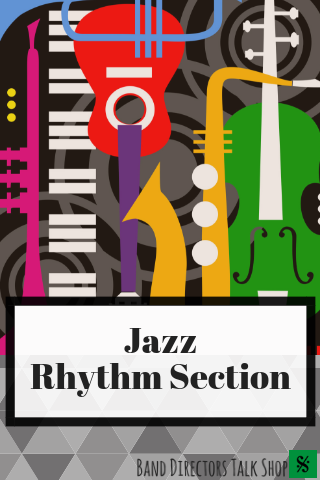The secret to improving your big band is by focusing on the rhythm section. They are the red carpet upon which the rest of the band walks upon. Therefore, if you have a solid foundation, then your band will have the confidence to play their part. Here are a few techniques for rehearsing your rhythm section.

Starting from the ground up: bass and drums
The core of the rhythm section is comprised of the piano, guitar, bass, and drums, and the heart of the rhythm section is the bass and drums. Together they set the tone of the song by establishing the basic pulse and time-feel or groove and their parts almost always complement each other. So, start there and rehearse only these two players. Then build upon that by adding your comping instruments one at a time until you hear the entire section.
Groove
A good groove arises from musicians thinking alike and working together as a team, despite the fact that they play different instruments. The essential elements of a good groove are volume, sound, and time.
Volume
The groove is the sound of musicians playing together, so if one instrument is louder than the others then there is no groove. Each instrument should be clearly heard, so make sure the volume of each instrument suits everyone else accordingly.
Sound
Besides volume, what is a good sounding rhythm section? One that plays together without getting in each other’s way. This means simplifying their playing so that they work together as a team. A drummer or bass player who plays too many fills will disrupt the flow of the groove. Remind them that less is more! Multiple comping instruments playing at the same time can be overwhelming, so consider having one play ‘pads’ or held chords in the upper register while the other plays rhythmic punctuations in the middle register. This will allow each instrument to have its own sonic space and unique function without getting in each other’s way. Groove is a happy feeling and the result of musicians playing and interacting together; they should not be overpowering, competing, or resisting each other.
Time
The key to a good rhythm section is when everybody plays with good time. Actually, this is also the key to a good sounding band: when everyone has good time. The essence of the jazz ensemble is that every member of the band, including the director, is a drummer. Everybody is responsible for the time and this can’t be emphasized enough. Rhythm section players are most responsible for outlining the time and have a stronger rhythmic role. After all, they are the rhythm section.
Metronome
A good way to emphasize this fact is to rehearse with a metronome. At the end of the day, the whole band should be aware of the time. If your rhythm section is having problems maintaining the tempo, then have them practice playing along with a metronome in rehearsal. This will alert them to the importance of keeping time.
With an electric metronome (on your smartphone or otherwise), simply plug it into an amplifier (with an ⅛” to ¼” adapter) and turn it up loud enough for everyone to hear while playing. It is an excellent exercise in playing good time and helps internalize the tempo while, most importantly, promoting metronome practice on their own time.
For jazz swing tunes at a nice medium tempo, the metronome should be placed on beats ‘two’ and ‘four’. Because of the importance of feeling the music on these beats, it helps to also practice this way. For example, if the tune is at quarter note = 120, then place the metronome at 60 and count it off. At first, it may be difficult to feel – depending on the level of your band you may need to begin with quarter notes – but it soon becomes easier. Think of it as just hearing the snare drum on a pop song.
If it is too difficult to play the actual chart, have the students play or sing something they are familiar with; it can be something as simple as singing the roots of a blues chord progression. Vocalizing time is a great way towards internalizing time.
Regardless of feel (rock, swing, bossa nova), this is a good exercise to improve your band and to promote metronome practice. I hope these tips were helpful for you. Feel free to email any questions you may have.
Related Reading:
Developing a Jazz Program: Strategies and Solutions
If You Build It, They Will Swing
Common Swing Pitfalls in Young Jazz Bands (and How to Solve Them)
If you would like to receive our weekly newsletter, sign up here.
Don’t forget to like us on Facebook too!
Learn. Share. Inspire.
BandDirectorsTalkShop.com






Leave a Reply
You must be logged in to post a comment.